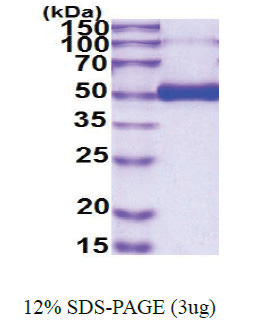Osteoprotegerin / TNFRSF11B (22-401, His-tag) Human Protein
CAT#: AR09137PU-N
Osteoprotegerin / TNFRSF11B (22-401, His-tag) human recombinant protein, 0.15 mg
Size: 30 ug
Other products for "TNFRSF11B"
Specifications
| Product Data | |
| Species | Human |
| Expression Host | Insect |
| Expression cDNA Clone or AA Sequence |
ADPETFPPKY LHYDEETSHQ LLCDKCPPGT YLKQHCTAKW KTVCAPCPDH YYTDSWHTSD ECLYCSPVCK ELQYVKQECN RTHNRVCECK EGRYLEIEFC LKHRSCPPGF GVVQAGTPER NTVCKRCPDG FFSNETSSKA PCRKHTNCSV FGLLLTQKGN ATHDNICSGN SESTQKCGID VTLCEEAFFR FAVPTKFTPN WLSVLVDNLP GTKVNAESVE RIKRQHSSQE QTFQLLKLWK HQNKDQDIVK KIIQDIDLCE NSVQRHIGHA NLTFEQLRSL MESLPGKKVG AEDIEKTIKA CKPSDQILKL LSLWRIKNGD QDTLKGLMHA LKHSKTYHFP KTVTQSLKKT IRFLHSFTMY KLYQKLFLEM IGNQVQSVKI SCLHHHHHH
|
| Tag | His-tag |
| Predicted MW | 44.7 kDa |
| Concentration | lot specific |
| Purity | >90% by SDS - PAGE |
| Presentation | Purified |
| Buffer | Presentation State: Purified State: Liquid purified protein Buffer System: PBS (pH 7.4) containing 10% glycerol |
| Endotoxin | < 1.0 EU per 1µg of protein (determined by LAL method ) |
| Preparation | Liquid purified protein |
| Protein Description | Recombinant human osteoprotegerin protein, fused to His-tag at C-terminus, was expressed in insect cell using baculovirus expression system and purified by using conventional chromatography techniques. |
| Note | (On SDS-PAGE under denatured condition, apparent molecular weight of glycosylated rhOPG protein will be appeared at approximately 55kDa). |
| Storage | Store undiluted at 2-8°C for one month or (in aliquots) at -20°C for longer. Avoid repeated freezing and thawing. |
| Stability | Shelf life: one year from despatch. |
| Reference Data | |
| RefSeq | NP_002537 |
| Locus ID | 4982 |
| UniProt ID | O00300 |
| Cytogenetics | 8q24.12 |
| Synonyms | OCIF; OPG; PDB5; TR1 |
| Summary | The protein encoded by this gene is a member of the TNF-receptor superfamily. This protein is an osteoblast-secreted decoy receptor that functions as a negative regulator of bone resorption. This protein specifically binds to its ligand, osteoprotegerin ligand, both of which are key extracellular regulators of osteoclast development. Studies of the mouse counterpart also suggest that this protein and its ligand play a role in lymph-node organogenesis and vascular calcification. Alternatively spliced transcript variants of this gene have been reported, but their full length nature has not been determined. [provided by RefSeq, Jul 2008] |
| Protein Families | Druggable Genome, Secreted Protein |
| Protein Pathways | Cytokine-cytokine receptor interaction |
Documents
| FAQs |
| SDS |
Resources
Recombinant Protein Resources |
{0} Product Review(s)
0 Product Review(s)
Submit review
Be the first one to submit a review
Product Citations
*Delivery time may vary from web posted schedule. Occasional delays may occur due to unforeseen
complexities in the preparation of your product. International customers may expect an additional 1-2 weeks
in shipping.






























































































































































































































































 Germany
Germany
 Japan
Japan
 United Kingdom
United Kingdom
 China
China
